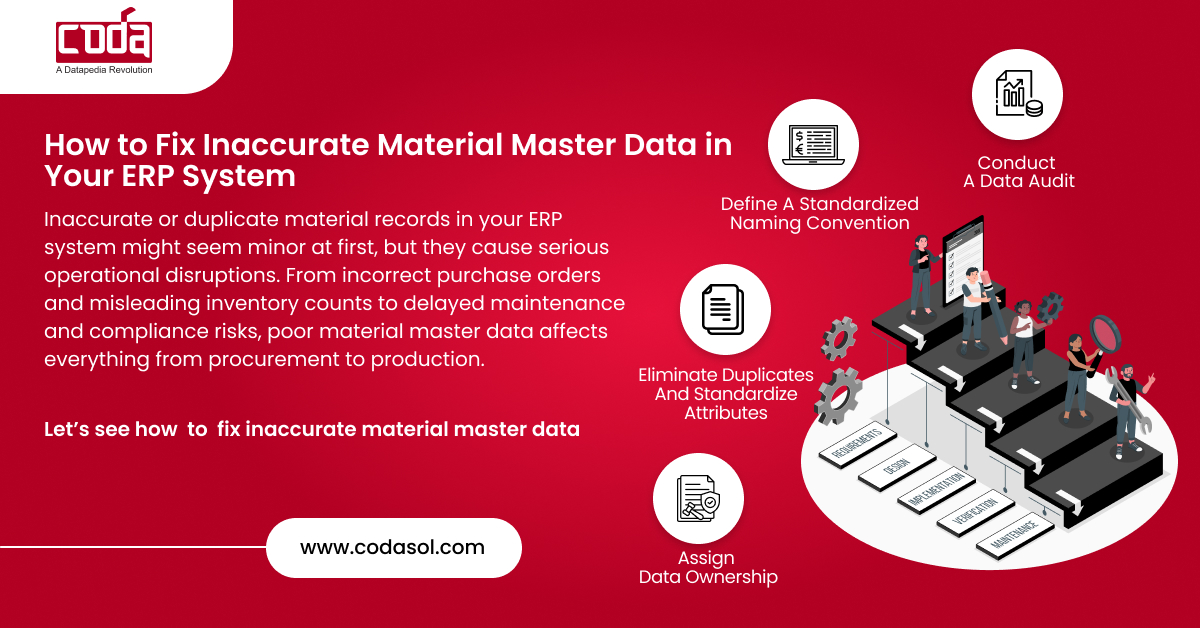If Your Supply Chain Is Struggling, Start with Your Material Master Data
You’re chasing delayed deliveries, dealing with wrong parts being shipped, and overstocking materials you already have. You may think it’s a process issue, but often, the real culprit is bad data. Fix inaccurate material master data in your ERP system.
In this blog, we’ll explore how inaccurate data disrupts supply chain performance, how to identify it, and most importantly, how to fix it.
Why Fixing Material Master Data Should Be a Top Priority
Material master data forms the backbone of any ERP system. It informs procurement, inventory, maintenance, production, and even finance.
When this data is flawed:
- Procurement orders the wrong parts
- Inventory levels are misleading
- Duplicate materials increase working capital
- Maintenance suffers from delays
In high-stakes industries like oil & gas, aviation, or manufacturing, this means millions lost annually.
The Root Causes of Inaccurate Material Master Data
Here are the most common sources of bad data in your ERP:
- Manual data entry errors
- Duplicate records from lack of naming conventions
- Obsolete or outdated material descriptions
- Inconsistent units of measure
- Lack of ownership or data governance
Example: A plant in Abu Dhabi discovered that 14% of its inventory was duplicated under different names and units. After a cleanup, it saved over $1.2M in procurement costs.
Step-by-Step Guide to Fix Inaccurate Material Master Data
1. Conduct a Data Audit
Start with a health check:
- How many material records do you have?
- What percentage are duplicated?
- Are naming conventions consistent?
- Are attributes like manufacturer name, unit of measure, and specs standardized?
Pro Tip: Use automated tools or consult a Master Data Management (MDM) provider for faster auditing.
2. Define a Standardized Naming Convention
Create templates for naming materials based on category (e.g., mechanical parts vs. electrical components). Ensure it includes:
- Noun-modifier structure
- Manufacturer details
- Key specs (size, capacity, pressure, etc.)
Sample Naming Convention for Valves:
| Noun | Modifier | Spec | Unit | Manufacturer |
|---|---|---|---|---|
| Valve | Gate | 4-inch, 300 PSI | EA | Cameron |
3. Eliminate Duplicates
Use data cleansing tools or MDM platforms to:
- Merge duplicate entries
- Remove obsolete records
- Map legacy codes to standard materials

Need help identifying duplicates in your ERP? Contact us for a Material Master Health Check.
4. Standardize Attributes
Create mandatory fields for:
- Part numbers
- Unit of measure
- Manufacturer name
- Equipment compatibility
This ensures consistency across all departments.
5. Assign Data Ownership
Without accountability, bad data creeps back in.
- Assign roles for data stewards
- Set up approval workflows
- Define access controls for editing material records
6. Integrate with Procurement and Maintenance
Make sure your material master is aligned with:
- Procurement systems to prevent wrong purchases
- Maintenance systems (like Maximo or SAP PM) to ensure accurate spare part planning
7. Implement Ongoing Data Governance
One-time cleanups are not enough. Set up a governance strategy with:
- Routine audits
- Approval-based changes
- Periodic deduplication
Results You Can Expect
| Impact Area | Before Fix | After Fix |
|---|---|---|
| Procurement | Frequent wrong orders | 90% accuracy in orders |
| Inventory | Overstocking & stockouts | 20% optimized inventory |
| Finance | Unexplained cost variances | Reduced maverick spending |
| Maintenance | Delayed spares availability | Improved uptime by 30% |
When to Seek External Help
If your ERP contains over 10,000+ materials, or if multiple plants/regions use different standards, fixing data internally can be overwhelming.
An external MDM provider can:
- Accelerate cleanup using AI/ML tools
- Ensure compliance with ISO standards
- Deliver a “golden record” for each item

Tired of bad data slowing you down? Discover how our AI-powered platform PROSOL can clean and enrich your ERP master data.
FAQs
1. How often should I clean material master data?
Ideally, perform a full audit annually, with quarterly checks for new entries.
2. Can inaccurate material master data affect compliance?
Absolutely. Regulatory audits often fail due to incorrect specifications or missing traceability in material records.
3. What is a “golden record”?
It’s the most complete, accurate, and up-to-date version of a material, deduplicated and enriched with correct attributes.
4. How long does a full cleanup take?
It depends on volume, but for a mid-sized manufacturer (50,000 materials), a full cleanup takes 8–12 weeks with the right tools.
5. Can this help reduce procurement costs?
Yes, by eliminating duplicates and ensuring correct specs, procurement costs can drop by up to 20%.
Fixing inaccurate material master data isn’t just about good housekeeping; it’s about unlocking operational excellence across your supply chain. Don’t let bad data cost you big.

